Low-Profile UWB-MIMO Antenna System with Enhanced Isolation Using Parasitic Elements and Metamaterial Integration
Abstract
:1. Introduction
2. Antenna Design and Configuration
3. Design Process of the Single Element
4. Design of the Proposed UWB-MIMO Antenna
5. Investigation of the MIMO-Antenna Diversity Performance
5.1. Envelope Correlation Coefficient (ECC)
5.2. Diversity Gain (DG)
5.3. Total Active Reflection Coefficient (TARC)
5.4. Channel Capacity Loss (CCL)
5.5. Mean Effective Gain (MEG)
6. Conclusions
Author Contributions
Funding
Data Availability Statement
Conflicts of Interest
References
- Che, F.; Ahmed, Q.Z.; Lazaridis, P.I.; Sureephong, P.; Alade, T. Indoor Positioning System (IPS) Using Ultra-Wide Bandwidth (UWB)—For Industrial Internet of Things (IIoT). Sensors 2023, 23, 5710. [Google Scholar] [CrossRef]
- Gupta, M.; Kumar, A.; Aggarwal, B.; Cengiz, K.; Singh, G. 5G Wireless Communication System in Healthcare Informatics; CRC Press: Boca Raton, FL, USA, 2023; ISBN 9781032312194. [Google Scholar]
- Zhang, R.; Liang, Y.C.; Hall PS, P.; Gardner, P.; Kelly, J.; Ebrahimi, E. Federal Communications Commission revision of Part 15 of the commission’s rules regarding ultra-wideband transmission systems. FCC Wash. DC First Rep. Order 2009, 48, 133–135. [Google Scholar]
- Youssef, A.A. Adaptive LDPC Coded High Data Rate Based IR-UWB Combined with VMIMO System for Vehicular Communication Links. AEU-Int. J. Electron. Commun. 2023, 169, 154747. [Google Scholar] [CrossRef]
- Gvozdarev, A.S.; Alishchuk, A.M.; Kazakova, M.A. Closed-Form Capacity Reliability Analysis of Multiuser MIMO System in the Presence of Generalized Multipath Fading. Sensors 2023, 23, 2289. [Google Scholar] [CrossRef]
- Sohi, A.K.; Kaur, A. Slot and SRR-Loaded Quad-Port, Hen-Shaped Fractal UWB-MIMO Antenna with Quad Band-Reject Ability for Handheld 4G/5G Wireless Devices. Iran. J. Sci. Technol. Trans. Electr. Eng. 2023, 47, 1187–1205. [Google Scholar] [CrossRef]
- Gurjar, R.; Upadhyay, D.K.; Kanaujia, B.K.; Sharma, K. A Novel Compact Self-Similar Fractal UWB-MIMO Antenna. Int. J. RF Microw. Comput.-Aided Eng. 2019, 29, e21632. [Google Scholar] [CrossRef]
- Altaf, A.; Iqbal, A.; Smida, A.; Smida, J.; Althuwayb, A.A.; Hassan Kiani, S.; Alibakhshikenari, M.; Falcone, F.; Limiti, E. Isolation Improvement in UWB-MIMO Antenna System Using Slotted Stub. Electronics 2020, 9, 1582. [Google Scholar] [CrossRef]
- Kulkarni, J.; Alharbi, A.G.; Sim, C.-Y.-D.; Elfergani, I.; Anguera, J.; Zebiri, C.; Rodriguez, J. Dual Polarized, Multiband Four-Port Decagon Shaped Flexible MIMO Antenna for Next Generation Wireless Applications. IEEE Access 2022, 10, 128132–128150. [Google Scholar] [CrossRef]
- Patel, A.; Desai, A.; Elfergani, I.; Vala, A.; Mewada, H.; Mahant, K.; Patel, S.; Zebiri, C.; Rodriguez, J.; Ali, E. UWB CPW Fed 4-Port Connected Ground MIMO Antenna for Sub-Millimeter-Wave 5G Applications. Alex. Eng. J. 2022, 61, 6645–6658. [Google Scholar] [CrossRef]
- Kaur, H.; Singh, H.S.; Upadhyay, R. Design and Analysis of Compact Quad-Element MIMO Antenna with Asymmetrical Ground Structures for Ultra-Wideband Communication. Wirel. PersCommun 2022, 124, 3105–3127. [Google Scholar] [CrossRef]
- Sheriff, N.; Kamal Abdul Rahim, S.; Tariq Chattha, H.; Kim Geok, T. Multiport Single Element Mimo Antenna Systems: A Review. Sensors 2023, 23, 747. [Google Scholar] [CrossRef]
- Biswas, A.K.; Chakraborty, U. Reduced Mutual Coupling of Compact MIMO Antenna Designed for WLAN and WiMAX Applications. Int. J. RF Microw. Comput. Aided Eng. 2019, 29, e21629. [Google Scholar] [CrossRef]
- Addepalli, T.; Anitha, V.R. Design and Analysis of a Novel Compact Spanner-Shaped Ultra-Wideband Antenna for MIMO Systems. Int. J. Commun. Syst. 2021, 34, e4739. [Google Scholar] [CrossRef]
- Amroun, A.; Zebiri, C.; Sayad, D.; Elfergani, I.T.E.; Desai, A.; Bouknia, M.L.; Zegadi, R.; Rodriguez, J. Miniaturized Six-Ring Elliptical Monopole-Based MIMO Antenna for Ultrawideband Applications. Int. J. Commun. Syst. 2023, 36, e5557. [Google Scholar] [CrossRef]
- Kumar, A.; Ansari, A.Q.; Kanaujia, B.K.; Kishor, J.; Matekovits, L. A review on different techniques of mutual coupling reduction between elements of any MIMO antenna. Part 1: DGSs and parasitic structures. Radio Sci. 2021, 56, e2020RS007122. [Google Scholar] [CrossRef]
- Kumar, P.; Pathan, S.; Vincent, S.; Kumar, O.P.; Yashwanth, N.; Kumar, P.; Shetty, P.R.; Ali, T. A Compact Quad-Port UWB-MIMO Antenna with Improved Isolation Using a Novel Mesh-like Decoupling Structure and Unique DGS. IEEE Trans. Circuits Syst. II Express Briefs 2023, 70, 949–953. [Google Scholar] [CrossRef]
- Abbas, M.A.; Allam, A.; Gaafar, A.; Elhennawy, H.M.; Sree, M.F.A. Compact UWB-MIMO Antenna for 5G Millimeter-Wave Applications. Sensors 2023, 23, 2702. [Google Scholar] [CrossRef]
- Patel, A.; Vala, A.; Desai, A.; Elfergani, I.; Mewada, H.; Mahant, K.; Zebiri, C.; Chauhan, D.; Rodriguez, J. Inverted-L Shaped Wideband MIMO Antenna for Millimeter-Wave 5G Applications. Electronics 2022, 11, 1387. [Google Scholar] [CrossRef]
- Desai, A.; Palandoken, M.; Elfergani, I.; Akdag, I.; Zebiri, C.; Bastos, J.; Rodriguez, J.; Abd Alhameed, R.A. Transparent 2-Element 5G MIMO Antenna for Sub-6 GHz Applications. Electronics 2022, 11, 251. [Google Scholar] [CrossRef]
- Das, P.; Singh, A.K.; Mandal, K. Metamaterial Loaded Highly Isolated Tunable Polarisation Diversity MIMO Antennas for THz Applications. Opt. Quant. Electron. 2022, 54, 250. [Google Scholar] [CrossRef]
- Gayatri, T.; Srinivasu, G.; Chaitanya, D.M.K.K.; Sharma, V.K. High Isolation Four-Port Wrench Shaped Compact UWB-MIMO Antenna for 3.1–10.6 GHz Band. PIER C 2022, 122, 67–82. [Google Scholar] [CrossRef]
- Babu, N.S.; Ansari, A.Q.; Kanaujia, B.K.; Singh, G.; Kumar, S. A Two-Port UWB-MIMO Antenna with an EBG Structure for WLAN/ISM Applications. Mater. Today Proc. 2023, 74, 334–339. [Google Scholar] [CrossRef]
- Sanmugasundaram, R.; Natarajan, S.; Rajkumar, R. A compact MIMO antenna with electromagnetic bandgap structure for isolation enhancement. Prog. Electromagn. Res. C 2021, 107, 233–244. [Google Scholar] [CrossRef]
- Fritz-Andrade, E.; Jardon-Aguilar, H.; Tirado-Mendez, J.A. Mutual Coupling Reduction of Two 2x1 Triangular-Patch Antenna Array Using a Single Neutralization Line for MIMO Applications. Radioengineering 2018, 27, 976–982. [Google Scholar] [CrossRef]
- Banerjee, J.; Gorai, A.; Ghatak, R. A Novel Isolation Improvement Technique Using Fractal Neutralization Line with Dual Band Rejection Attributes in a Compact UWB-MIMO Antenna. Int. J. Microw. Wirel. Technol. 2022, 15, 1–12. [Google Scholar] [CrossRef]
- Kumar, P.; Ali, T.; Mm, M.P. Characteristic Mode Analysis-Based Compact Dual Band-Notched UWB-MIMO Antenna Loaded with Neutralization Line. Micromachines 2022, 13, 1599. [Google Scholar] [CrossRef]
- Dkiouak, A.; El Ouahabi, M.; Chakkor, S.; Baghouri, M.; Zakriti, A.; Lagmich, Y. High Performance UWB-MIMO Antenna by Using Neutralization Line Technique. Prog. Electromagn. Res. C 2023, 131, 185–195. [Google Scholar] [CrossRef]
- Li, Y.; Bian, L.; Xu, K.; Liu, Y.; Wang, Y.; Chen, R.; Xie, S. Mutual Coupling Reduction for Monopole MIMO Antenna Using L-Shaped Stubs, Defective Ground and Chip Resistors. AEU-Int. J. Electron. Commun. 2023, 160, 154524. [Google Scholar] [CrossRef]
- Iqbal, A.; Saraereh, O.A.; Ahmad, A.W.; Bashir, S. Mutual coupling reduction using F-shaped stubs in UWB-MIMO antenna. IEEE Access 2017, 6, 2755–2759. [Google Scholar] [CrossRef]
- Li, Z.; Du, Z.; Takahashi, M.; Saito, K.; Ito, K. Reducing mutual coupling of MIMO antennas with parasitic elements for mobile terminals. IEEE Trans. Antennas Propag. 2011, 60, 473–481. [Google Scholar] [CrossRef]
- Revati, C.G.; Patil, R.R. Slot-based mutual coupling reduction technique for MIMO antenna. SN Comput. Sci. 2021, 2, 104. [Google Scholar] [CrossRef]
- You, X.; Du, C.; Yang, Z.P. A Flexible CPW 2-Port Dual Notched-Band UWB-MIMO Antenna for Wearable IoT Applications. Prog. Electromagn. Res. C 2023, 128, 155–168. [Google Scholar] [CrossRef]
- Asadpor, L.; Rezvani, M. Multiband microstrip MIMO antenna with CSRR loaded for GSM and LTE applications. Microw. Opt. Technol. Lett. 2018, 60, 3076–3080. [Google Scholar] [CrossRef]
- Tirado-Mendez, J.A.; Jardon-Aguilar, H.; Flores-Leal, R.; Rangel-Merino, A.; Vasquez-Toledo, L.A.; Rodriguez-Colina, E.; Marcelin-Jimenez, R.; Pascoe-Chalke, M. Metamaterial Split-Ring Resonators Applied as Reduced-Size Four-Port Antenna Array for MIMO Applications. AEU-Int. J. Electron. Commun. 2022, 154, 154338. [Google Scholar] [CrossRef]
- Kumar, A.; Ansari, A.Q.; Kanaujia, B.K.; Kishor, J.; Matekovits, L. A review on different techniques of mutual coupling reduction between elements of any MIMO antenna. Part 2: Metamaterials and many more. Radio Sci. 2021, 56, e2020RS007222. [Google Scholar] [CrossRef]
- Islam, H.; Das, S.; Ali, T.; Bose, T.; Dhar, S.; Rai, B.; Kumar, P. Compact circularly polarized 2 and 4 port multiple input multiple output antennas with band stop filter isolation technique. Alex. Eng. J. 2023, 66, 357–376. [Google Scholar] [CrossRef]
- Nadeem, I.; Choi, D.Y. Study on mutual coupling reduction technique for MIMO antennas. IEEE Access 2018, 7, 563–586. [Google Scholar] [CrossRef]
- Al-saedi AJ, H.; Perez, J.C. A Review: Compact size and isolation of MIMO antenna. PrzeglądElektrotechniczny 2022, 11–17. [Google Scholar] [CrossRef]
- Blanch, S.; Romeu, J.; Corbella, I. Exact Representation of Antenna System Diversity Performance from Input Parameter Description. Electron. Lett. 2003, 39, 705–707. [Google Scholar] [CrossRef]
- Govindan, T.; Palaniswamy, S.K.; Kanagasabai, M.; Kumar, S. Design and Analysis of UWB-MIMO Antenna for Smart Fabric Communications. Int. J. Antennas Propag. 2022, 2022, e5307430. [Google Scholar] [CrossRef]
- Alsharari, M.; Lavadiya, S.; Aliqab, K.; Armghan, A.; Daher, M.G.; Patel, S.K. A Novel Design of Complementary Split Ring Resonator Metamaterial-Based Low-Profile MIMO Antenna with Defected Ground Structure for S/C/X/Ka Band Applications. Micromachines 2023, 14, 1232. [Google Scholar] [CrossRef] [PubMed]
- Kiani, S.H.; Savci, H.S.; Munir, M.E.; Sedik, A.; Mostafa, H. An Ultra-Wide Band MIMO Antenna System with Enhanced Isolation for Microwave Imaging Applications. Micromachines 2023, 14, 1732. [Google Scholar] [CrossRef] [PubMed]

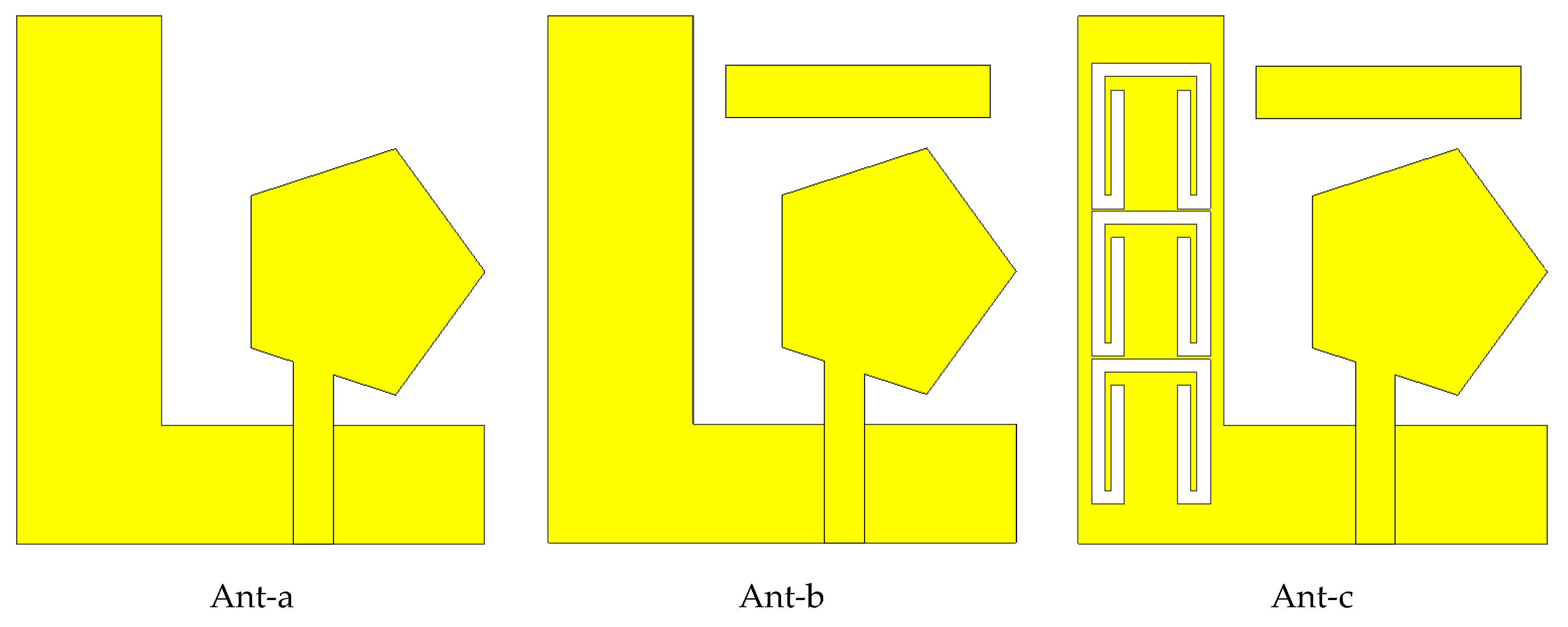


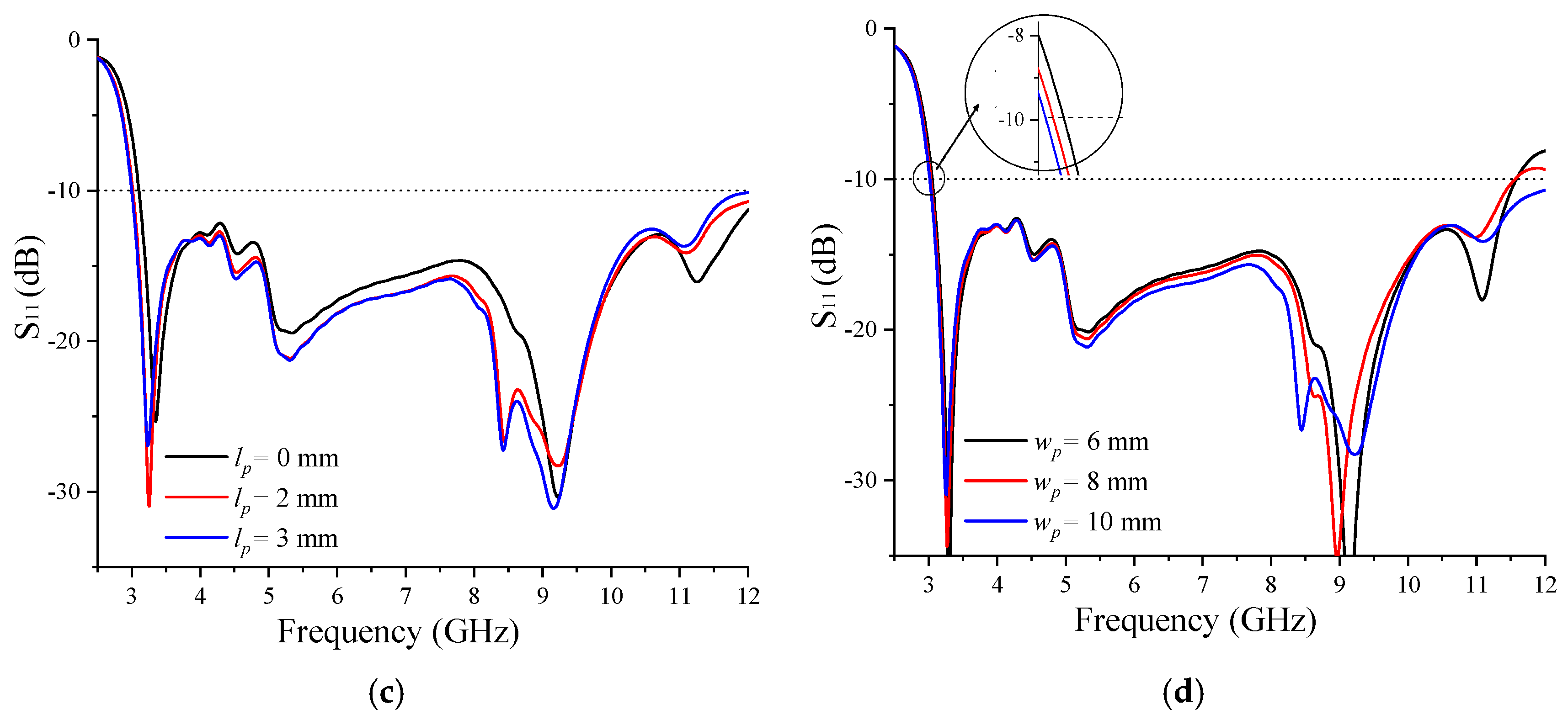

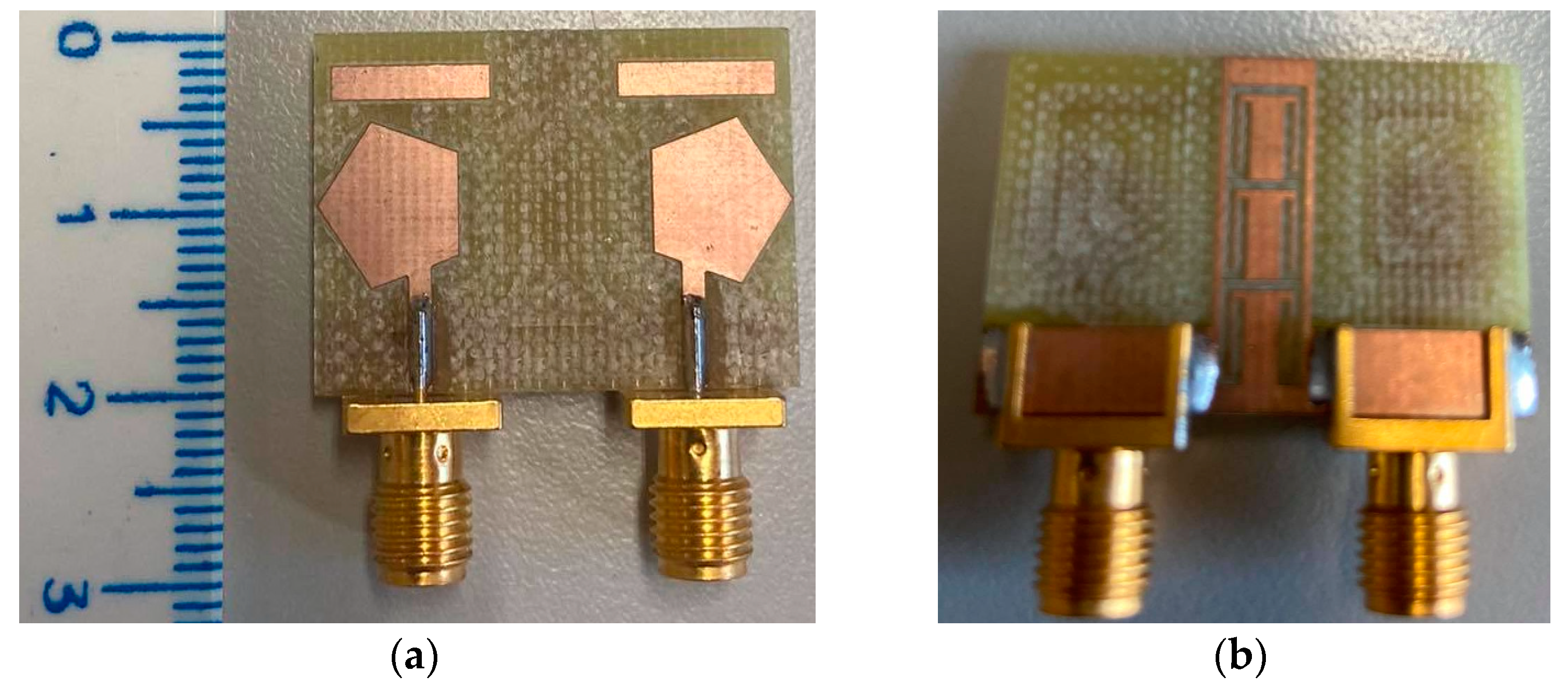

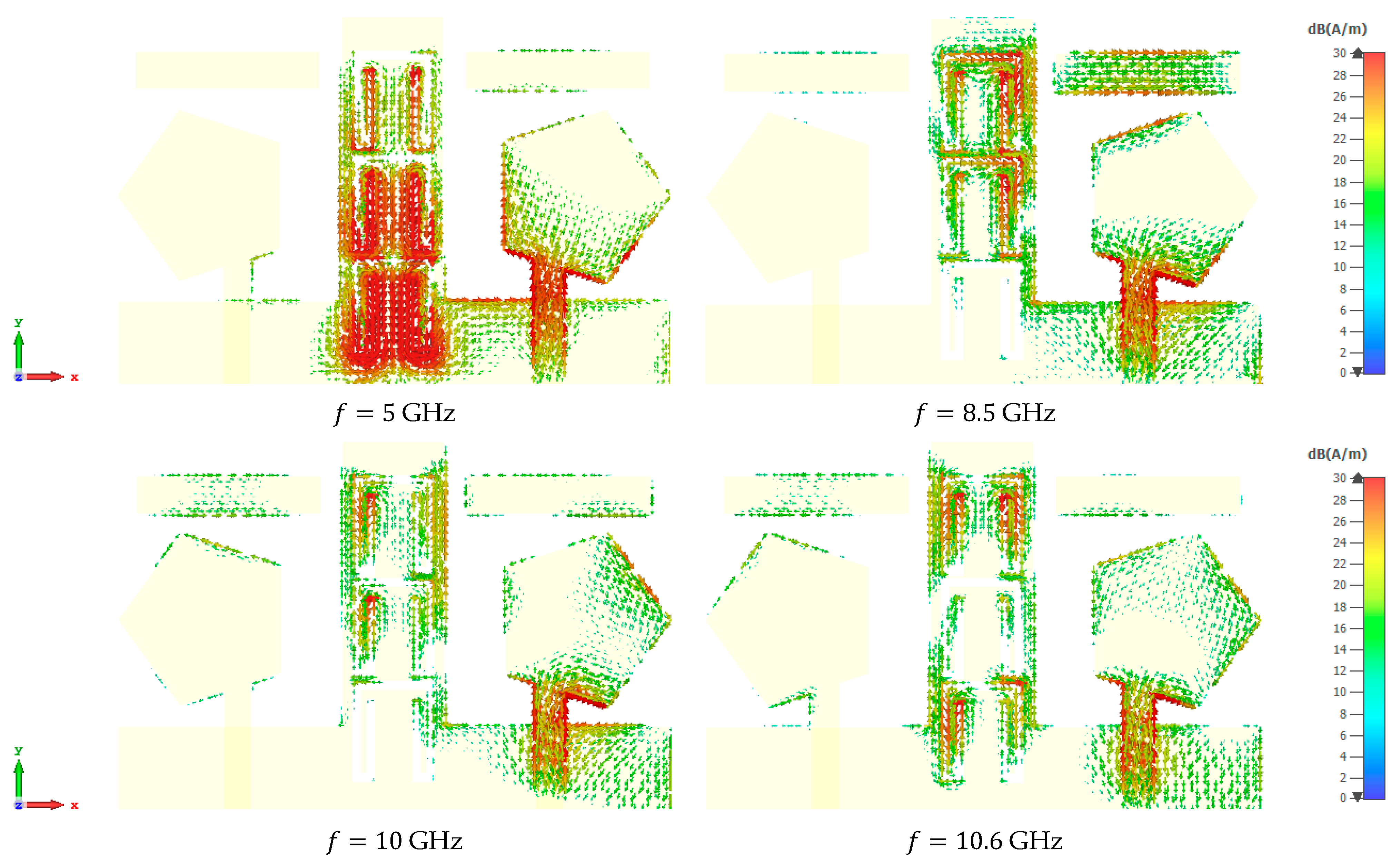

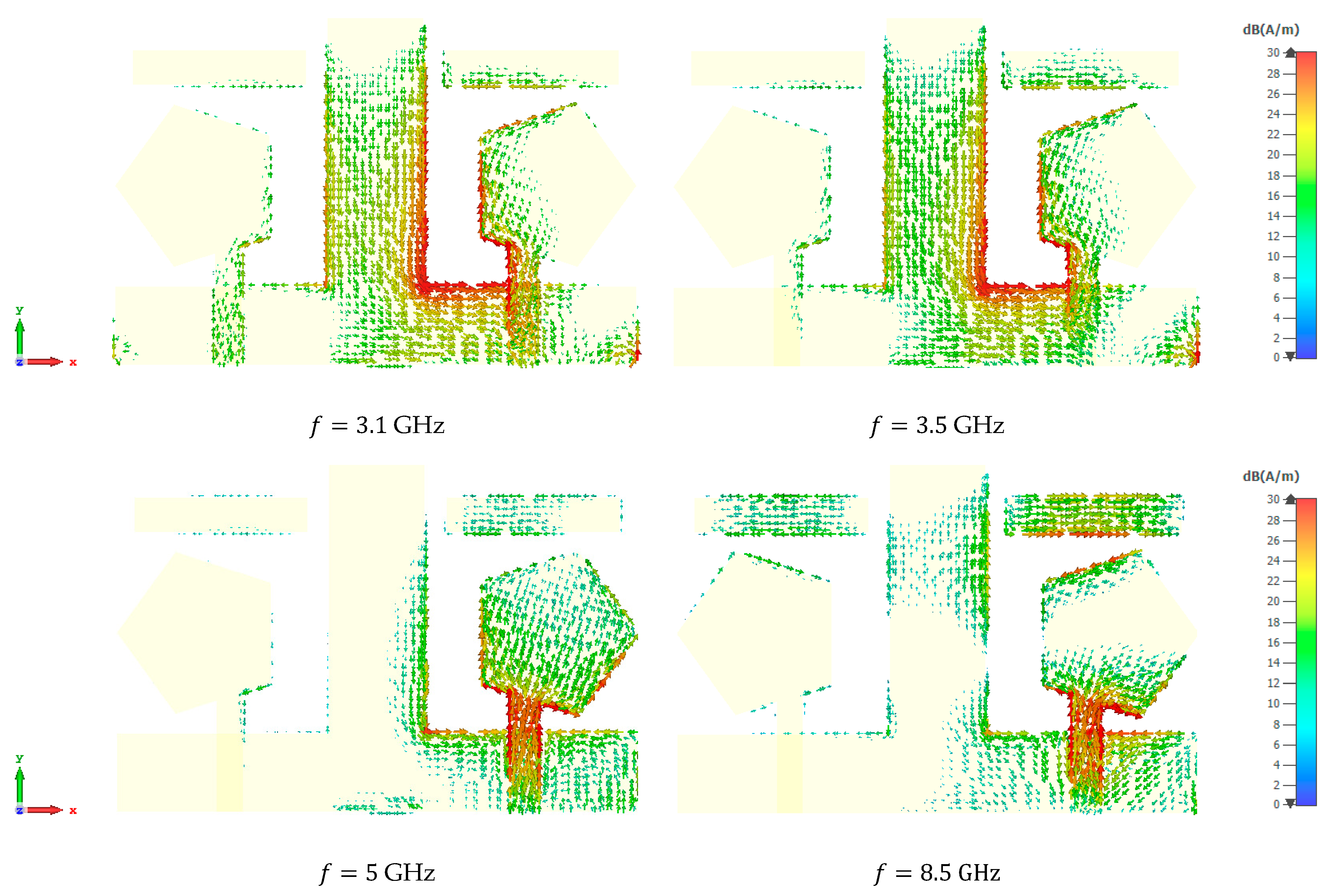




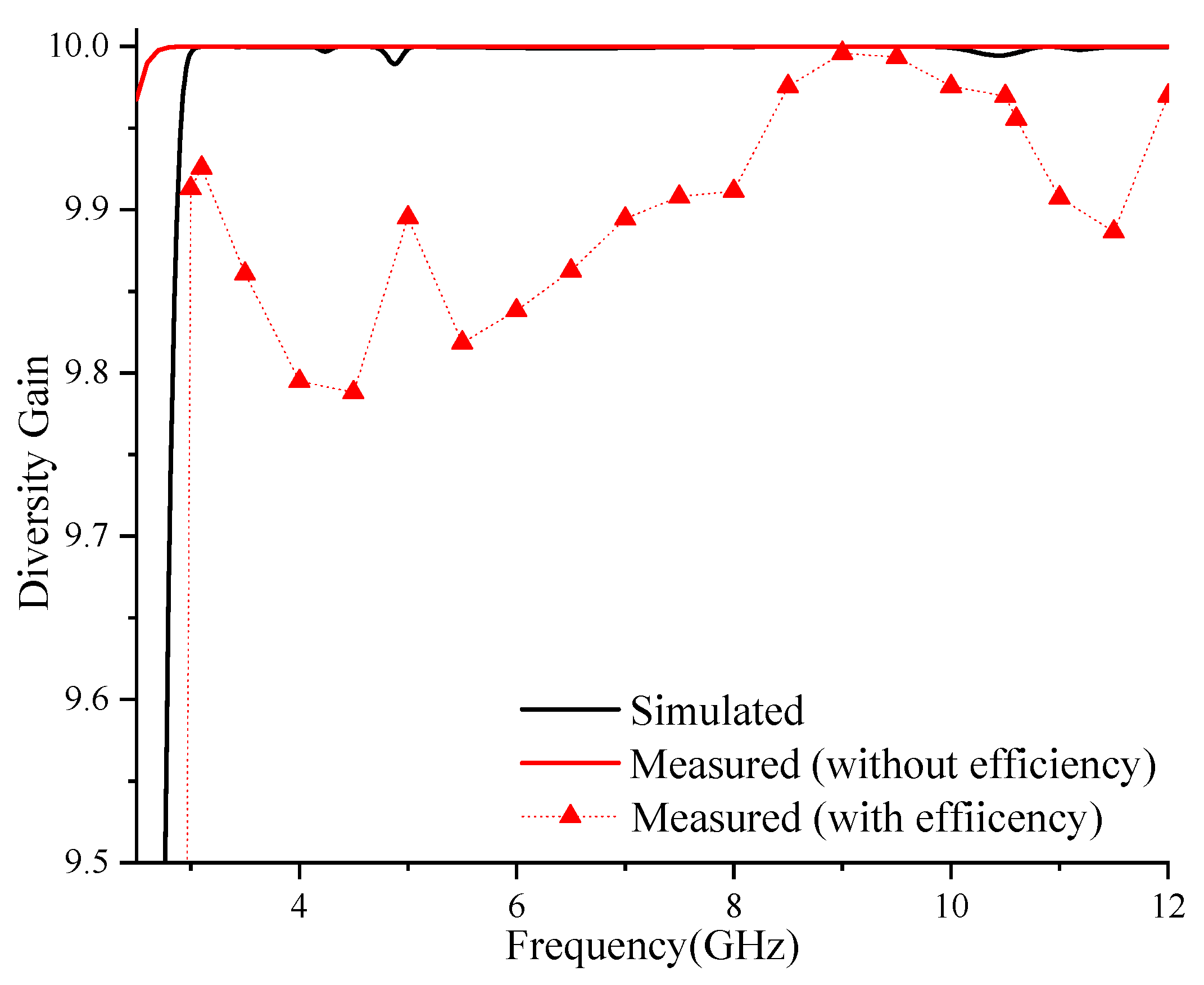



| Parameter | Value (mm) | Parameter | Value (mm) |
|---|---|---|---|
| 20 | 9.7 | ||
| 30 | 1.5 | ||
| 4.78 | 2 | ||
| 6.9 | 10 | ||
| 6.41 | 5.5 | ||
| 2.49 | 4.5 | ||
| 1.7 | 5.5 | ||
| 5.76 | 4.5 | ||
| 5.75 | 2.25 | ||
| 15.5 | 0.1 | ||
| 10.3 | 12.25 |
| Year | Ref. | Size (mm2) | Bandwidth (GHz) | No. of Ports | Isolation (dB) | Gain (dBi) | Efficiency (%) | ECC | DG (dB) | CCL (bits/Hz/s) | TARC (dB) | MEG (dB) |
|---|---|---|---|---|---|---|---|---|---|---|---|---|
| 2019 | [8] | 24 × 32 | 3.1–12.5 | 2 | ≥16 | 4.8 | NG | ≤0.05 | ≥9.9 | 0.4 | NG | ≤−3 |
| 2019 | [13] | 55 × 28 | 2.01–3.9 | 2 | ≥15 | 2 | NG | ≤0.01 | >9.8 | 0.2 | <0 | <−3 |
| 2020 | [9] | 33 × 48 | 2–13.7 | 2 | ≥20 | 4.3 | 96 | ≤0.15 | >9.85 | 0.06 | NG | NG |
| 2021 | [24] | 27.9 × 38 | 1.5–3.5 | 2 | ≥20 | NG | NG | <0.2 | NG | NG | NG | NG |
| 2022 | [20] | 70 × 25 | 4.65–4.97 | 2 | ≥15 | 1.65 | 45 | <0.03 | >9.8 | 0.15 | >−12 | 1 |
| 2022 | [33] | 29.5 × 60 | 3–20 | 2 | ≥23 | NG | 98 | <0.001 | >9.995 | 0.3 | NG | NG |
| 2023 | [23] | 30 × 60 | 3–12 | 2 | ≥25 | 5 | 90 | NG | NG | NG | NG | NG |
| 2023 | [28] | 46 × 46 | 3.1–11.7 | 2 | ≥16.5 | NG | 55 | <0.057 | >9.78 | ≤0.25 | ≤−10 | NG |
| 2023 | [37] | 29.5 × 60 | 3–15.7 | 2 | ≥20 | 6.2 | NG | <0.045 | >9.998 | 0.3 | NG | NG |
| 2023 | [43] | 52 × 26 | 2.3–11.5 | 2 | ≥16 | 5.9 | 98 | <0.012 | 10 | NG | NG | NG |
| Proposed antenna | 30 × 20 | 3.01–12.34 | 2 | ≥22 | 5.5 | 70 | <0.0025 | 10 | 0.15 | <−12 | −3 | |
Disclaimer/Publisher’s Note: The statements, opinions and data contained in all publications are solely those of the individual author(s) and contributor(s) and not of MDPI and/or the editor(s). MDPI and/or the editor(s) disclaim responsibility for any injury to people or property resulting from any ideas, methods, instructions or products referred to in the content. |
© 2023 by the authors. Licensee MDPI, Basel, Switzerland. This article is an open access article distributed under the terms and conditions of the Creative Commons Attribution (CC BY) license (https://creativecommons.org/licenses/by/4.0/).
Share and Cite
Tighilt, Y.; Bensid, C.; Sayad, D.; Mekki, S.; Zegadi, R.; Bouknia, M.L.; Elfergani, I.; Singh, P.; Rodriguez, J.; Zebiri, C. Low-Profile UWB-MIMO Antenna System with Enhanced Isolation Using Parasitic Elements and Metamaterial Integration. Electronics 2023, 12, 4852. https://doi.org/10.3390/electronics12234852
Tighilt Y, Bensid C, Sayad D, Mekki S, Zegadi R, Bouknia ML, Elfergani I, Singh P, Rodriguez J, Zebiri C. Low-Profile UWB-MIMO Antenna System with Enhanced Isolation Using Parasitic Elements and Metamaterial Integration. Electronics. 2023; 12(23):4852. https://doi.org/10.3390/electronics12234852
Chicago/Turabian StyleTighilt, Yamina, Chahrazed Bensid, Djamel Sayad, Samira Mekki, Rami Zegadi, Mohamed Lamine Bouknia, Issa Elfergani, Pankaj Singh, Jonathan Rodriguez, and Chemseddine Zebiri. 2023. "Low-Profile UWB-MIMO Antenna System with Enhanced Isolation Using Parasitic Elements and Metamaterial Integration" Electronics 12, no. 23: 4852. https://doi.org/10.3390/electronics12234852
APA StyleTighilt, Y., Bensid, C., Sayad, D., Mekki, S., Zegadi, R., Bouknia, M. L., Elfergani, I., Singh, P., Rodriguez, J., & Zebiri, C. (2023). Low-Profile UWB-MIMO Antenna System with Enhanced Isolation Using Parasitic Elements and Metamaterial Integration. Electronics, 12(23), 4852. https://doi.org/10.3390/electronics12234852










